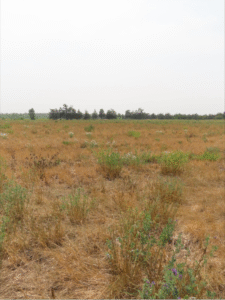Winter 2024 and Spring 2025 Conditions
Regular freeze-thaw cycles occurred, but with so much snow cover across most of the province, few fields were exposed to very cold air temperatures. Springtime reports indicated there was below-average alfalfa winterkill.
On March 28th, 2025 an ice storm struck central and eastern Ontario, as well as the counties around Georgian Bay. The storm may have worsened drown-outs of forage crops in low-lying areas of fields, but in general, field crop damage from the storm was negligible. Significant clean-up of tree limbs was necessary before first cut could begin.
Hay and Haylage
Spring Conditions
A cool spring delayed alfalfa development, which pushed first cut harvest back on many farms. Spring conditions for seeding were generally good. A notable exception was the area between Brighton and Kingston, which was too wet to work throughout May. Some fields were seeded in early June.
Disease Pressure
Snow mould was reported in western Ontario on orchardgrass in early spring. Orchardgrass is known to be less winter hardy than many other common forage grass species. This winter stress may have contributed to other disease issues later in the year. Reports came in from Perth and Elgin counties of fusarium/pythium root and crown rots, and anthracnose.
Summer Drought
Minimal rain fell between Highway 400 and Kingston from the first week of June until well into August. Few farms had enough regrowth on their hay crops to take a cut (either second or third, depending on the farm) until the rain started again. Many alfalfa acres were cut during the fall rest period to make up feed inventories. Early spring scouting in 2026 will be key to determine winterkill levels and management strategies to meet yield requirements on these stressed stands.
Summer Insect Issues
Armyworm outbreaks in hay crops were reported in late July from Peterborough and Northumberland counties.
Pastures
Spring Growth
Pastures grew well during the cool spring in 2025. Turnout timing was typical for most producers across the province.
Summer Water Stress
Prolonged hot and dry summer weather in central and eastern Ontario strained water sources. Dugouts, streams, and wells went dry. Some farmers started hauling water to livestock in July. Initially, the worst-affected areas included Kawartha Lakes, Peterborough, Northumberland, and Prince Edward counties. In August, scattered showers started to fall in this area, but the dry weather worsened to the east and north into September. High straw yields, salvaged corn crops, and lower grain prices provide options to feed livestock through the winter. At the time of writing, drinking water for livestock and rural properties remains a challenge for many people east of Highway 400.

Wildfire Risk
Dry weather and large amounts of debris left in the bush from the ice storm in March increased the number of wildfires occurring south of the French and Mattawa Rivers. Some of these fires prompted voluntary evacuation of livestock off pasture farms.
Annual Forage Crops
Winter Triticale
Winter triticale acres seeded in the fall of 2024 were higher again, continuing a trend over the past three years. Heavy snow mould pressure affected many of these acres in the spring of 2025. Triticale responds well to management and thrives under high-fertility programs.
Silage Corn
Silage corn harvest began earlier than normal, as grain corn released by Agricorp in very dry areas was salvaged for forage. Nitrate poisoning and silo gas were top concerns, especially when scattered rainfall began to occur in those dry pockets. Nitrogen moves into plant roots with water. When rain ends a dry spell, plants take up a lot of water, which can result in excess nitrogen uptake. It takes time for the plants to turn excess nitrogen into protein, and nitrate poisoning can be a risk if the crop is harvested before protein synthesis can occur. High nitrate levels in plants also increase the risk of N2O, or nitrous oxide gas forming as the silo is filled, which can be deadly to people and animals. Feed testing salvaged corn is essential, since starch content may be much lower than normal. Some silage corn was put up drier than optimal, due to weather stress and early frosts impacting moisture content and the rate of dry-down.

DON Survey
The 2025 Ontario Grain Corn Ear Mould and Deoxynivalenol (DON) Survey found 98% of samples tested low (below 2.00 parts per million (ppm)) for DON, which makes 2025 one of the lowest DON level seasons in the past 10 years of the survey. While the survey does not include leaves and stalks, it is still a useful indicator on how likely mycotoxin issues will be with corn silage fed over the next year.
Fall Forage Establishment
Exceptionally dry conditions in central and eastern Ontario following wheat harvest limited the number of acres where annual forages were established this fall. September was dry across the province. Cover crops and annual forages came on slowly, with below-normal yields.
Agricorp
Claim payments for the excess Forage Rainfall option were paid in August to producers across the province for a total of $1.58 million, which is below the 5-year average of $3.2 million. The 2025 growing season started off wet in May and turned very dry in most areas throughout the rest of the forage growing season. As a result, the insufficient rainfall option claim payments were a total of $7.7 million for 2025, which is well above the 5-year average $3.7 million. The highest payout year to date was 2021 ($11 million), followed by 2025 ($9.28 million), and 2020 ($8 million).
There were 56,655 acres insured under the standard and premium options of the New Forage Seeding production insurance program in 2025. Total claims paid were $692,392.
Upcoming Events
December 2-4: Forage Focus webinar series. 7:30 pm Eastern / 6:30 pm Central. Details and registration at https://onforagenetwork.ca/ontario-forage-council/forage-focus/
